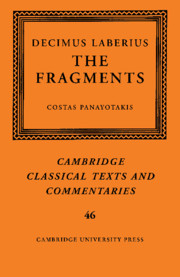Preface and Acknowledgements
Published online by Cambridge University Press: 05 June 2012
Summary
My interest in the Roman mime originated in the early 1990s when, as a PhD student at the University of Glasgow, I studied under the supervision of P. G. Walsh the episodic novel of Petronius from a theatrical point of view (a revised version of my PhD Thesis appeared with the title Theatrum Arbitri: Theatrical elements in the Satyrica of Petronius (Leiden 1995)). During my analysis of theatricality in Petronius I realised how important to the author of the Satyrica, and to ancient novelists in general, mime was as a structural device, and how inadequate our primary sources were for an understanding of this unique theatrical form. Its significance can be seen both in the frequent exploitation of various mime-motifs by authors of widely divergent literary genres such as love-elegy, satire, and the novel, and in the prominent role mime played in the shaping of medieval and modern popular theatre.
What survives from the scripts of the Roman literary mime today comprises some 55 titles of plays, a number of literary fragments (not all of them considered to be genuine extracts) which amount to about 200 lines, and a collection of over 730 sententiae, some of which are attributed to the mimographer Publilius. It is far from certain that all of these one-line apophthegms, which lack a theatrical context and were composed in iambic or trochaic metres, were written by him. The length of the remaining mime-fragments, composed usually in senarii or septenarii, varies from one word to 27 lines.
- Type
- Chapter
- Information
- Decimus LaberiusThe Fragments, pp. vii - xiiPublisher: Cambridge University PressPrint publication year: 2010



